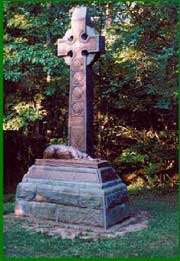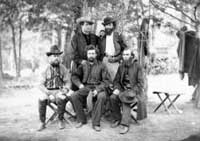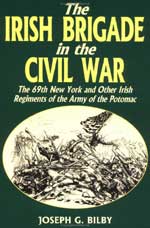| |

Traditions, folklore, history and more. If it's Irish, it's here. Or will be!
"People will not look forward to posterity who never look backward to their ancestors."
-Edmund Burke




Quotes
Library: Books, Movies, Music
Prints & Photos
Poetry
Jokes


Shops Ireland
Bunús na Gaeilge
(Basic Irish)
Circle of Prayer
Blessings
Did You Know?
Himself/Herself
Write to Us
Readers Write..
Links/Link to Us
Advertise with us
Awards & Testimonials
Submissions Guide


|
|
|
The Irish Soldiers in the American Civil War
by Bridget Haggerty
 “His cavalry is numerous but can’t ride and his infantry, except the Irish, can’t fight.” Confederate Col. E. P. Alexander commenting on the Union forces. “His cavalry is numerous but can’t ride and his infantry, except the Irish, can’t fight.” Confederate Col. E. P. Alexander commenting on the Union forces.
It is estimated that approximately 360,000 Union soldiers died as a direct result of the war. The Confederacy lost 133,000 dead. Many more soldiers were wounded; some maimed for life. One source has said that one in nine who served were either Irish born, or of Irish descent. Based on these numbers, nearly 50,000 Irish soldiers gave their lives in battle, and countless others were injured.
About 190,000 Irishmen contributed to both sides of the cause. It is estimated that 150,000 served on the side of the Union and that about 40,000 served the Confederacy. After the conflict was over, more than 130 Irish soldiers had been awarded the Medal of Honor.
Many factors led to the large number of immigrant soldiers. Like it or not, the Irish were viewed with suspicion and much prejudice as wave after wave of emigrants arrived from the famine stricken country. Most were very poor, most were Catholic, and most were thought to be capable of no better than servant work or hard labor. Thus, a considerable number of Irishmen enlisted to receive pay for their work, as well as clothing, shelter and food. It was also said that the Irish were well suited for the fighting life, having had plenty of practice on their home soil.
 Two main Union regiments were the 63rd, 69th, 88th New York (The Irish Brigade under Thomas Francis Meagher, February 1862 - June 1864) and the 9th Massachusetts. For the Confederacy, the majority of the Irish appear to have enlisted in the 17th South Carolina and the 6th Louisiana. Two main Union regiments were the 63rd, 69th, 88th New York (The Irish Brigade under Thomas Francis Meagher, February 1862 - June 1864) and the 9th Massachusetts. For the Confederacy, the majority of the Irish appear to have enlisted in the 17th South Carolina and the 6th Louisiana.
However, of all the units that fought in the Civil War, the Irish Brigade is probably the most well known. Comprised of troops from New York who were mostly Irish-Catholics, this unit proved itself in some of the most important battles.
While this writer was familiar with key Civil War figures such as U. S. Grant (whose maternal grandfather was from Co. Tyrone), Meagher, Cleburne, Sheridan, Corcoran, and so many others who are famous for their bravery and leadership in battle, a principal player in the Irish Brigade - their chaplain, Fr. William Corby - was an unknown entity. This led to more research and the discovery of a remarkably brave priest who ministered tirelessly to his troops. Through his devotions and his willingness to be ever-present at the encampments, as well as at the front, the souls of the Irish Brigade were always cared for. However, there was one moment, one gesture, for which his is best-remembered.
 On July, 2, 1863, just a tiny remnant of the Irish Brigade remained. Once numbering in the thousands, just 530 men were left. Led by Galway-born Colonel Patrick Kelly, they prepared to fight in Rose's Wheatfield. (Later, it would become known as simply "The Wheatfield.") With the din of battle raging around them, Fr. Corby stood upon a rock and granted the soldiers general absolution. This was an extraordinary action that had never been witnessed by those present. Undoubtedly it made a profound impression and a huge difference to the spirits of the soldiers. The outnumbered brigade later emerged from the battle minus forty percent of its men, but with all of its flags and its honor intact. On July, 2, 1863, just a tiny remnant of the Irish Brigade remained. Once numbering in the thousands, just 530 men were left. Led by Galway-born Colonel Patrick Kelly, they prepared to fight in Rose's Wheatfield. (Later, it would become known as simply "The Wheatfield.") With the din of battle raging around them, Fr. Corby stood upon a rock and granted the soldiers general absolution. This was an extraordinary action that had never been witnessed by those present. Undoubtedly it made a profound impression and a huge difference to the spirits of the soldiers. The outnumbered brigade later emerged from the battle minus forty percent of its men, but with all of its flags and its honor intact.
Following the war, Fr. Corby returned to the University of Notre Dame where he eventually became president. In 1886, he was elected Provincial General of the Congregation of the Holy Cross for the United States. Later he became Assistant General for the worldwide order. He died of pneumonia on December 28, 1897. His casket was borne to the grave, not by his fellow Holy Cross priests as was the custom, but by aging Civil War veterans. His coffin was draped in the flag of his old regiment and a rifle volley was fired as his coffin was lowered into the grave. Accompanied by the sound of a bugle, old Grand Army of the Republic veterans sang a song over their heroic chaplain's grave:
"Answering the call of roll on high.
Dropping from the ranks as they make reply
Filling up the army of the by and by"
On October 29, 1910, a bronze statue of Father Corby was dedicated on the battlefield at Gettysburg, the only one ever placed on that celebrated field to memorialize a chaplain.
Irish Brigade Monument at Gettysburg
On July 2, 1888, one of the most distinctive memorials on the Gettysburg battlefield was dedicated on the twenty-fifth anniversary of the Irish Brigade fight in the Wheatfield. The three New York regiments combined their state appropriations to have the memorial created. Father Corby attended the dedication ceremony where he blessed the monument and held a military mass for the returning brigade veterans.
The artist, Willian Rudolph O'Donovan, (ironically an ex-Confederate soldier who had fought the Union army at Gettysburg), created a bronze and granite base supporting a carved Celtic cross with a life-sized Irish wolfhound lying at the base mourning its lost masters. The cross bears the trefoil corps badge of the Second Corps, in which the brigade served, as well as four medallions containing the numeric designations of the three NY regiments, and the seal of the State of New York. Beneath the medallions there is an additional bronze panel depicting numerous symbols of Ireland. Bronze plaques at the base of the cross provide brief histories of the regiments.
“No words of mine can fittingly describe the heroic conduct of the men in whose memory this monument has been erected. Their deeds will be remembered in song and in story so long as the history of our country is read.”
Col. James D. Brady
Transfer of Monument Speech, July 2, 1888

Suggested Reading
Memoirs of Chaplain Life: Three years with the Irish Brigade in the Army of the Potomac

The Irish Brigade in the Civil War: The 69th New York and Other Irish Regiments of the Army of the Potomac
Origin of Memorial Day
In Retired Major General Logan's proclamation of what was then called Decoration Day, he declared: "The 30th of May, 1868, is designated for the purpose of strewing with flowers, or otherwise decorating the graves of comrades who died in defense of their country and during the late rebellion, and whose bodies now lie in almost every city, village and hamlet churchyard in the land. In this observance no form of ceremony is prescribed, but posts and comrades will in their own way arrange such fitting services and testimonials of respect as circumstances may permit."
The two ceremonies were joined in 1868, and northern states commemorated the day on May 30. The southern states commemorated their war dead on different days. Children read poems and sang civil war songs and veterans came to school wearing their medals and uniforms to tell students about their experiences. Then the veterans marched through their home towns followed by the townspeople to the cemetery.
In 1882, the name was changed to Memorial Day and soldiers who had died in previous wars were honored as well. In the northern United States, it was designated a public holiday. In 1971, President Richard Nixon declared Memorial Day a federal holiday on the last Monday in May.
Resources:
Content
http://irishvolunteers.tripod.com/medal_honor.htm
http://www.alleghany.k12.nc.us/gcs/ireland/civilwar.htm
http://www1.va.gov/pubaff/mday/mdayorig.htm
http://homeschooling.about.com/cs/unitssubjhol/a/memorial.htm
http://www.paulmartinart.com/EgoTeAbsolvo.html
Images:
Irish Brigade Monument
Father John Corby
|
|
Fri, Sep 27, 2024
 The Galway Hooker The Galway Hooker
This unique vessel, with its distinctive curved lines and bright red sails, originated in the village of Claddagh. During the 19th century, hookers supported a significant fishing industry and also carried goods, livestock and fuel. Seán Rainey is remembered for building the last of the original boats, the Truelight, for Martin Oliver who was to become the last king of the Claddagh; as king, he was entitled to white sails on his boat. Since the mid seventies, many of the old sailing craft which were on the verge of extinction have been lovingly restored and new ones have been built. During the summer months they can be seen at festivals such a Cruinniú na mBád - the Gathering of the Boats - in Kinvara.
Click for More Culture Corner.
This unconventional perspective helps to shed light on an aspect of Irish nationalism many writers have shamefully and unforgiveably neglected. Writing with passion, the author manifests the exploits of Irishmen and women during the euphemistically renowned "Great War", via the employment of official war sources and contemporary letters from those at the front line. The book sets the scene and the building miasma around some of the war's major conflicts that were to result in serious loss of life borne out of the ineptitude of senior command. In short, it is a lugubrious reflection of the horrors and realities of war, and of the previously "unknown" heroes Ireland can now rightly call its own.
Click here for Irish Voices.
|
More than a quarter of a million Irishmen fought in the Great War. The publication in 1996 of Dungan's Irish Voices from the Great War contributed to the awareness of the injustice done to the Irishmen of the 1914-18 War. This companion volume uses the same type of material (letters, diaries, memoirs, personal interviews) to advance that process.
A companion volume to Irish Voices from the Great War, this book complements that anthology of tragedy with further stories of unromanticised life in the trenches, the experience of POWs, and an illuminating and critical look at the role of chaplains.
Danny Morrison, Sunday Tribune.
Click here for They Shall Not Grow Old.
Thousands of Irishmen lined up at the recruiting stations and served in both the Confederate and Union armies - great names such as O'Rourke, Corcoran, Meagher, McIntosh, McGavock, and Tilghman. Unlike their English neighbors, who, for the most part, assimilated into the Union and Confederate ranks, many Irishmen organized their own, unique units made up of their fellows and included the adjective "Irish" within their regimental names. As their memories disappeared into history, they left their names, their songs and poems, their letters and battle accounts - and their photographs - to remind them of their passing and allow us to walk part of the way with them.
Publisher's Review
Click here for Faces of the Civil War.
|
|
|
|
|




 The Galway Hooker
The Galway Hooker